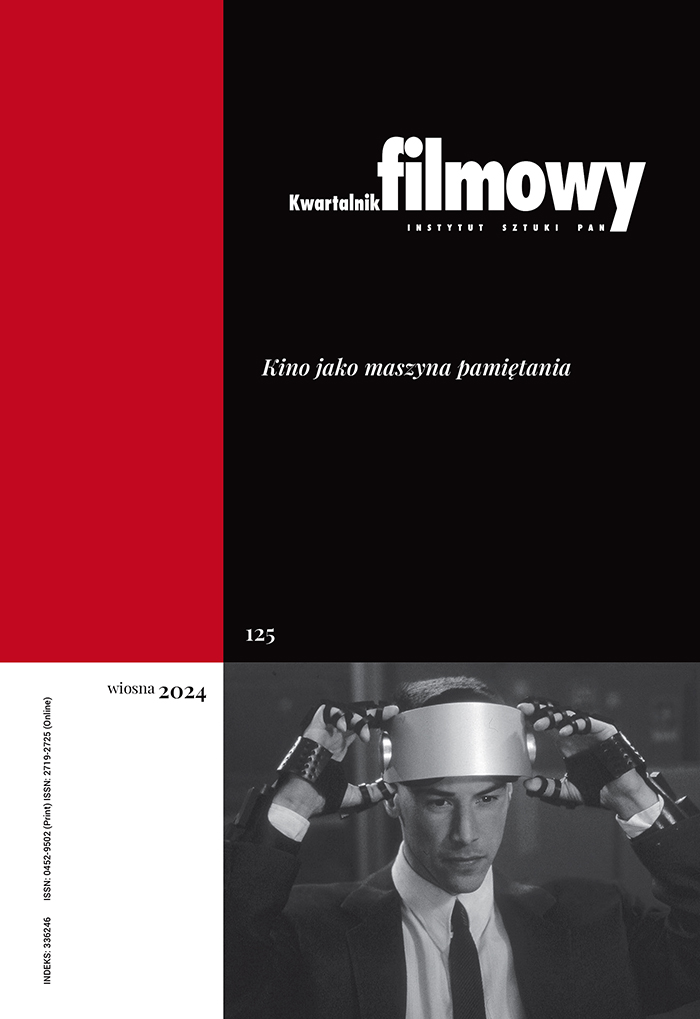Spontaneous Cinema
Abstract
Giżycki discusses the art of improvisation in film making. This aspect of creativity is, he argues, one of the most neglected ones by the scholars. According to Giżycki the first improvisers in the history of the cinema were the brothers Lumiere, who filmed everything that happened in front of their cameras, whereas the first self-conscious improvisations were probably made by Feliks Kuczkowski, a long forgotten pioneer of Polish animated film. Unfortunately no trace of his work survives. The first surviving attempt of spontaneous cinema identified by Giżycki is Man Ray's Return to Reason (1923), who thanks to that particular film became one of the founding fathers of the whole genre of frameless film in experimental cinema, and a precursor of non-camera films. Non-camera films, especially the abstract ones, became one of the most responsive mediums for spontaneous cinema. The author considers work of this type made by Stan Brakhage and Norman McLaren, and he also mentions David Ehrlich and Jonas Mekas. The article is concluded by a manifest of spontaneous cinema, in which the author shows why spontaneous films are worth watching and filming.
Keywords:
spontaneous cinema, improvisation, Feliks Kuczkowski, Man RayReferences
Brakhage Stan, Telling Time: Essays of a Visionary Filmmaker, Kingston 2003, s. 78-79.
Google Scholar
Giżycki Marcin, Walka o film artystyczny w międzywojennej Polsce, Warszawa 1989, s. 226.
Google Scholar
Irzykowski Karol, Dziesiąta Muza, Kraków 1924, s. 218.
Google Scholar
Janta-Połczyński Aleksander, Stolica srebrnej magii, Warszawa 1936, s. 96-97.
Google Scholar
Kuczkowski Feliks, Wspomnienia o filmie przyszłości, Warszawa 1955, maszynopis w zbiorach Filmoteki Narodowej.
Google Scholar
McLaren Norman, Animated Films, w: R. Russett, C. Starr, Experimental Animation: Origins of a New Art, New York 1976, s. 123.
Google Scholar
McWilliams Donald (red.), Norman McLaren: On the Creative Process, Montreal 1991 (broszura towarzysząca płycie DVD Norman McLaren: Selected Films), s. 45.
Google Scholar
Mekas Jonas, Just Like a Shadow... An Interview with Jerome Sans, w: Jonas Mekas: Just Like a Shadow, red. P. Remy, Paris 2000.
Google Scholar
Ray Man, Self Portrait, Boston 1988, s. 212.
Google Scholar
Richard Vallière T., Norman McLaren: Manipulator of Movement, London-Toronto 1982, s. 76.
Google Scholar
Themerson Stefan, O potrzebie tworzenia widzeń, „f.a.” 1937, nr 2.
Google Scholar
Authors
Marcin Giżyckikwartalnik.filmowy@ispan.pl
Rhode Island School of Design United States
Krytyk i historyk sztuki, autor książek z dziedziny historii filmu i zjawisk kultury artystycznej. Wykładowca w Rhode Island School of Design w USA. Opublikował m.in. Nie tylko Disney—rzecz o kinie animowanym (2000), Koniec i co dalej? (2001), Słownik kierunków, ruchów i kluczowych pojec sztuki drugiej połowy XX wieku (2002), Wenders do domu! Europejskie filmy o Ameryce i ich recepcja w Stanach Zjednoczonych (2006).
Statistics
Abstract views: 1107PDF downloads: 127
License
Copyright (c) 2009 Marcin Giżycki

This work is licensed under a Creative Commons Attribution 4.0 International License.
The author grants the publisher a royalty-free non-exclusive licence (CC BY 4.0) to use the article in Kwartalnik Filmowy, retains full copyright, and agrees to identify the work as first having been published in Kwartalnik Filmowy should it be published or used again (download licence agreement). The journal is published under the CC BY 4.0 licence. By submitting an article, the author agrees to make it available under this licence.
In issues from 105-106 (2019) to 119 (2022) all articles were published under the CC BY-NC-ND 4.0 licence. During this period the authors granted a royalty-free non-exclusive licence (CC BY-ND 4.0) to use their article in „Kwartalnik Filmowy”, retained full copyright, and agreed to identify the work as first having been published in our journal should it be published or used again.
Most read articles by the same author(s)
- Marcin Giżycki, Smartphone – The Triumph of Eisenstein , Kwartalnik Filmowy: No. 112 (2020): Polish Documentary, Polish Animation
- Marcin Giżycki, … Only Stills Remained: Nonexistent Films of Cindy Sherman , Kwartalnik Filmowy: No. 115 (2021): Form Film, Content Film
- Marcin Giżycki, „L’âge d’or” – the Masterpiece of Provocation , Kwartalnik Filmowy: No. 109 (2020): Architectural Space in Film
- Marcin Giżycki, The Last Wizard of Western World , Kwartalnik Filmowy: No. 34 (2001): Cinema at the Turn of the Century
- Marcin Giżycki, Why I Do Not Like Advertising in the Cinema , Kwartalnik Filmowy: No. 105-106 (2019): Cinema and Political Transformation
- Marcin Giżycki, Expanded Cinema Thirty Years Later , Kwartalnik Filmowy: No. 35-36 (2001): Cinema and New Media
- Marcin Giżycki, The Highs and Lows of Animation in Bohemia , Kwartalnik Filmowy: No. 81 (2013): Child in Film
- Marcin Giżycki, The Magical Beginnings of Cinema , Kwartalnik Filmowy: No. 74 (2011): Film Objects
- Marcin Giżycki, The Revenge of Joker and Parasites , Kwartalnik Filmowy: No. 108 (2019): Film Production and Distribution
- Marcin Giżycki, Tucker and Others , Kwartalnik Filmowy: No. 110 (2020): Beyond Human Being











